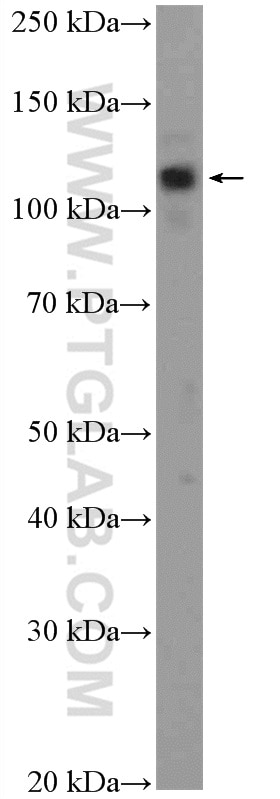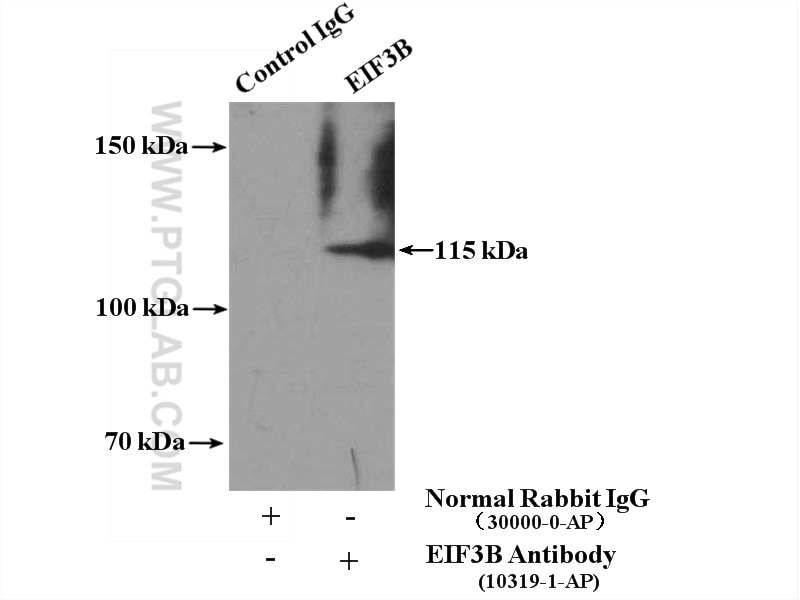Validation Data Gallery
Tested Applications
| Positive WB detected in | A375 cells |
| Positive IP detected in | A375 cells |
Recommended dilution
| Application | Dilution |
|---|---|
| Western Blot (WB) | WB : 1:200-1:1000 |
| Immunoprecipitation (IP) | IP : 0.5-4.0 ug for 1.0-3.0 mg of total protein lysate |
| It is recommended that this reagent should be titrated in each testing system to obtain optimal results. | |
| Sample-dependent, Check data in validation data gallery. | |
Published Applications
| WB | See 7 publications below |
| IF | See 2 publications below |
Product Information
10319-1-AP targets EIF3B in WB, IF, IP, ELISA applications and shows reactivity with human samples.
| Tested Reactivity | human |
| Cited Reactivity | human, mouse |
| Host / Isotype | Rabbit / IgG |
| Class | Polyclonal |
| Type | Antibody |
| Immunogen |
CatNo: Ag0386 Product name: Recombinant human EIF3B protein Source: e coli.-derived, PGEX-4T Tag: GST Domain: 381-562 aa of BC001173 Sequence: FSPCERYLVTFSPLMDTQDDPQAIIIWDILTGHKKRGFHCESSAHWPIFKWSHDGKFFARMTLDTLSIYETPSMGLLDKKSLKISGIKDFSWSPGGNIIAFWVPEDKDIPARVTLMQLPTRQEIRVRNLFNVVDCKLHWQKNGDYLCVKVDRTPKGTQGVVTNFEIFRMREKQVPVDVVEMK 相同性解析による交差性が予測される生物種 |
| Full Name | eukaryotic translation initiation factor 3, subunit B |
| Calculated molecular weight | 93 kDa |
| Observed molecular weight | 115 kDa |
| GenBank accession number | BC001173 |
| Gene Symbol | EIF3B |
| Gene ID (NCBI) | 8662 |
| RRID | AB_2096732 |
| Conjugate | Unconjugated |
| Form | |
| Form | Liquid |
| Purification Method | Antigen affinity purification |
| UNIPROT ID | P55884 |
| Storage Buffer | PBS with 0.02% sodium azide and 50% glycerol{{ptg:BufferTemp}}7.3 |
| Storage Conditions | Store at -20°C. Stable for one year after shipment. Aliquoting is unnecessary for -20oC storage. |
Background Information
EIF3B, also named as Eukaryotic translation initiation factor 3 subunit B, is a 814 amino acid protein, which contains 1 RRM (RNA recognition motif) domain and 8 WD repeats and belongs to the eIF-3 subunit B family. EIF3B as a RNA-binding component of the eukaryotic translation initiation factor 3 (eIF-3) complex, is required for several steps in the initiation of protein synthesis. The eIF-3 complex associates with the 40S ribosome and facilitates the recruitment of eIF-1, eIF-1A, eIF-2:GTP:methionyl-tRNAi and eIF-5 to form the 43S pre-initiation complex (43S PIC). The eIF-3 complex stimulates mRNA recruitment to the 43S PIC and scanning of the mRNA for AUG recognition. The eIF-3 complex is also required for disassembly and recycling of post-termination ribosomal complexes and subsequently prevents premature joining of the 40S and 60S ribosomal subunits prior to initiation. The eIF-3 complex specifically targets and initiates translation of a subset of mRNAs involved in cell proliferation, including cell cycling, differentiation and apoptosis, and uses different modes of RNA stem-loop binding to exert either translational activation or repression. The calculated molecular weight of EIF3B is 93 kDa, but the phosphorylated EIF3B protein is about 115 kDa.
Protocols
| Product Specific Protocols | |
|---|---|
| IP protocol for EIF3B antibody 10319-1-AP | Download protocol |
| WB protocol for EIF3B antibody 10319-1-AP | Download protocol |
| Standard Protocols | |
|---|---|
| Click here to view our Standard Protocols |
Publications
| Species | Application | Title |
|---|---|---|
Nucleic Acids Res SUMOylation of the m6A-RNA methyltransferase METTL3 modulates its function. | ||
Elife Translation initiation by the hepatitis C virus IRES requires eIF1A and ribosomal complex remodeling. | ||
Cancers (Basel) GDF15 Is an Eribulin Response Biomarker also Required for Survival of DTP Breast Cancer Cells. | ||
bioRxiv Novel gene-specific translation mechanism of dysregulated, chronic inflammation reveals promising, multifaceted COVID-19 therapeutics. | ||
Cell Chem Biol Non-canonical function of histone methyltransferase G9a in the translational regulation of chronic inflammation |


